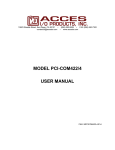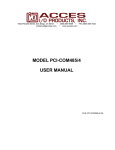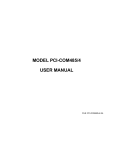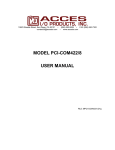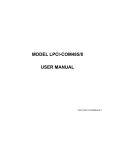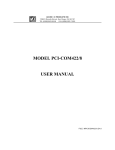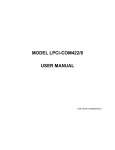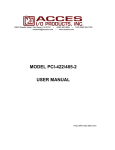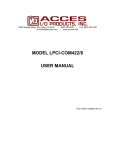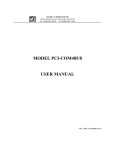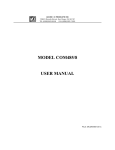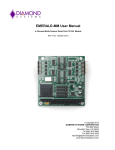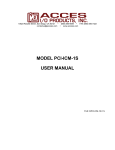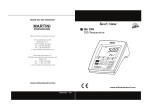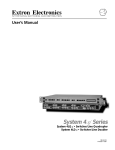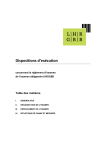Download MODEL PCI-COM422/4 USER MANUAL
Transcript
MODEL PCI-COM422/4
USER MANUAL
FILE: MPCICOM422-4.E1d
Notice
The information in this document is provided for reference only. Portwell does not assume any liability
arising out of the application or use of the information or products described herein. This document may
contain or reference information and products protected by copyrights or patents and does not convey
any license under the patent rights of Portwell, nor the rights of others.
IBM PC, PC/XT, and PC/AT are registered trademarks of the International Business Machines
Corporation.
Printed in USA. Copyright 1995, 2005 by Portwell I/O Products Inc. All rights reserved.
WARNING!!
ALWAYS CONNECT AND DISCONNECT YOUR FIELD CABLING WITH
THE COMPUTER POWER OFF. ALWAYS TURN COMPUTER POWER
OFF BEFORE INSTALLING A CARD. CONNECTING AND
DISCONNECTING CABLES, OR INSTALLING CARDS INTO A SYSTEM
WITH THE COMPUTER OR FIELD POWER ON MAY CAUSE DAMAGE
TO THE I/O CARD AND WILL VOID ALL WARRANTIES, IMPLIED OR
EXPRESSED.
2
Manual PCI-COM-422/4
Warranty
Prior to shipment, Portwell equipment is thoroughly inspected and tested to applicable specifications.
However, should equipment failure occur, Portwell assures its customers that prompt service and support
will be available. All equipment originally manufactured by Portwell which is found to be defective will be
repaired or replaced subject to the following considerations.
Terms and Conditions
If a unit is suspected of failure, contact Portwell' Customer Service department. Be prepared to give the
unit model number, serial number, and a description of the failure symptom(s). We may suggest some
simple tests to confirm the failure. We will assign a Return Material Authorization (RMA) number which
must appear on the outer label of the return package. All units/components should be properly packed for
handling and returned with freight prepaid to the Portwell designated Service Center, and will be returned
to the customer's/user's site freight prepaid and invoiced.
Coverage
First Three Years: Returned unit/part will be repaired and/or replaced at Portwell option with no charge for
labor or parts not excluded by warranty. Warranty commences with equipment shipment.
Following Years: Throughout your equipment's lifetime, Portwell stands ready to provide on-site or in-plant
service at reasonable rates similar to those of other manufacturers in the industry.
Equipment Not Manufactured by Portwell
Equipment provided but not manufactured by Portwell is warranted and will be repaired according to the
terms and conditions of the respective equipment manufacturer's warranty.
General
Under this Warranty, liability of Portwell is limited to replacing, repairing or issuing credit (at Portwell
discretion) for any products which are proved to be defective during the warranty period. In no case is Portwell
liable for consequential or special damage arriving from use or misuse of our product. The
customer is responsible for all charges caused by modifications or additions to Portwell equipment not
approved in writing by Portwell or, if in Portwell opinion the equipment has been subjected to abnormal
use. "Abnormal use" for purposes of this warranty is defined as any use to which the equipment is
exposed other than that use specified or intended as evidenced by purchase or sales representation.
Other than the above, no other warranty, expressed or implied, shall apply to any and all such equipment
furnished or sold by Portwell.
3
Manual PCI-COM-422/4
Table of Contents
Chapter 1: Introduction................................................................................................. 5
Figure 1-1: Block Diagram(Only One Serial Channel Shown) ........................................................... 7
Chapter 2: Installation................................................................................................... 8
Chapter 3: Option Selection ....................................................................................... 10
Figure 3-1: Simplified Termination Schematic................................................................................... 10
Figure 3-2: Option Selection Map...................................................................................................... 12
Chapter 4: Address Selection .................................................................................... 13
Chapter 5: Programming ............................................................................................ 14
Table 5-1: Baud Rate Divisor Values................................................................................................. 15
Chapter 6: Connector Pin Assignments.................................................................... 18
Table 6-1: Connector Pin Assignments ............................................................................................. 18
4
Manual PCI-COM-422/4
Chapter 1: Introduction
The card was designed for effective transmission in RS422 (EIA422) protocol. The card is 6.1 inches long
and may be installed in PCI-bus slots of IBM PC or compatible computers. The card features four
independent, asynchronous RS422 serial ports, type 16550 buffered UARTs, and, for Windows
compatibility, automatic control to transparently enable/disable the transmission drivers.
There are two I/O connector options. The standard model includes a single DB25 male connector on the
mounting bracket plus a breakout cable that terminates in four 9-pin female connectors. The optional
model has two 9-pin male connectors on the card mounting bracket plus a second mounting bracket with
two more 9-pin male connectors with ribbon cables to connect them to headers on the card.
RS422 Balanced Mode Operation
The card supports RS422 communications and uses differential balanced drivers for long range and
noise immunity. This card also has the capability to add load resistors to terminate the communications
lines. RS422 communications requires that a transmitter supply a bias voltage to ensure a known "zero"
state. Also, receiver inputs at each end of the network should be terminated to eliminate "ringing". The
card supports biasing by default and supports termination by jumpers on the card. If your application
requires the transmitter to be un-biased, please contact the factory.
COM Port Compatibility
Type 16550 UARTs are used as the Asynchronous Communication Element (ACE). These include a 16byte transmit/receive buffer to protect against lost data in multitasking operating systems, while
maintaining 100 percent compatibility with the original IBM serial port. The system assigns the
address(es).
A crystal oscillator is located on the card. This oscillator ensures precise selection of baud rates up to
115,200 or, by changing a jumper, up to 460,800 with the standard crystal oscillator.
The driver/receiver used, the SN75176B, is capable of driving extremely long communication lines at high
baud rates. It can drive up to +60 mA on balanced lines and receive inputs as low as 200 mV differential
signal superimposed on common mode noise of +12 V or -7 V. In case of communication conflict, the
driver/receivers feature thermal shutdown.
Communication Mode
This card supports Full-Duplex and Half-Duplex communications with a 4-wire cable connection. HalfDuplex allows traffic to travel in both directions, but only one way at a time.
Baud Rate Ranges
The card has capability for two baud rate ranges and you can select which you wish to use on a port-byport basis. One range is for up to 115,200 baud applications and the other is up to 460,800 baud
applications.
5
Manual PCI-COM-422/4
Specifications
Communications Interface
•
I/O Connection:
9-pin D-sub connectors
•
Serial Ports:
Four shielded male D-sub 9-pin IBM AT style connectors
compatible with RS422 specifications. (Note: On model
an external "spider" or breakout cable terminates with
four female D-sub 9-pin connectors.)
•
Character length:
5, 6, 7, or 8 bits.
•
Parity:
Even, odd or none.
•
Stop Interval:
1, 1.5, or 2 bits.
•
Serial Data Rates:
Up to 115,200 baud, Asynchronous, A faster range of
rates up to 460,800, is achieved by jumper selection on
the card. Type 16550 buffered UART.
•
Address:
Continuously mappable within 0000 to FFFF (hex) range
of PCI bus addresses (Conforms to PCI Specification
2.1).
•
Receiver Input Sensitivity:
+200 mV, differential input.
•
Common Mode Rejection:
+12V to -7V
•
Transmitter Output Drive Capability:
60 mA, with thermal shutdown.
Environmental
•
Operating Temperature Range: 0 °C. to +60 °C.
•
Storage temperature Range:
-50 °C. to +120 °C.
•
Humidity:
5% to 95%, non-condensing.
•
Size:
6.1" long (155 mm) by 3.9" (99 mm).
•
Power Required:
+5VDC at 125 mA typical, -12VDC at 5 mA typical,
+12VDC at 5 mA typical, 750 mW total power
consumption.
6
Manual PCI-COM-422/4
Figure 1-1: Block Diagram(Only One Serial Channel Shown)
7
Manual PCI-COM-422/4
Chapter 2: Installation
A printed Quick-Start Guide (QSG) is packed with the card for your convenience. If you’ve already
performed the steps from the QSG, you may find this chapter to be redundant and may skip forward to
begin developing your application.
The software provided with this card is on CD and must be installed onto your hard disk prior to use. To
do this, perform the following steps as appropriate for your operating system.
Configure Card Options via Jumper Selection
Before installing the card into your computer, carefully read Chapter 3: Option Selection of this manual,
then configure the card according to your requirements and protocol (RS-232, RS-422, RS-485, 4-wire
485, etc.). Our Windows based setup program can be used in conjunction with Chapter 3 to assist in
configuring jumpers on the card, as well as provide additional descriptions for usage of the various card
options (such as termination, bias, baud rate range, RS-232, RS-422, RS-485, etc.).
CD Software Installation
The following instructions assume the CD-ROM drive is drive “D”. Please substitute the appropriate drive
letter for your system as necessary.
DOS
1.
2.
3.
4.
Place the CD into your CD-ROM drive.
TypeB- to change the active drive to the CD-ROM drive.
Type GLQR?JJ-to run the install program.
Follow the on-screen prompts to install the software for this board.
WINDOWS
1.
Place the CD into your CD-ROM drive.
2.
The system should automatically run the install program. If the install program does not run
promptly, click START | RUN and type BGLQR?JJ, click OK or press -.
3.
Follow the on-screen prompts to install the software for this board.
LINUX
1.
Please refer to linux.htm on the CD-ROM for information on installing under linux.
Note: COM boards can be installed in virtually any operating system. We do support installation in earlier
versions of Windows, and are very likely to support future versions as well.
Caution! * ESD A single static discharge can damage your card and cause premature
failure! Please follow all reasonable precautions to prevent a static discharge such as grounding
yourself by touching any grounded surface prior to touching the card.
8
Manual PCI-COM-422/4
Hardware Installation
1.
2.
3.
4.
5.
6.
7.
8.
9.
10.
11.
Make sure to set switches and jumpers from either the Option Selection section of this manual or
from the suggestions of SETUP.EXE.
Do not install card into the computer until the software has been fully installed.
Turn OFF computer power AND unplug AC power from the system.
Remove the computer cover.
Carefully install the card in an available 5V or 3.3V PCI expansion slot (you may need to remove
a backplate first).
Inspect for proper fit of the card and tighten screws. Make sure that the card mounting bracket is
properly screwed into place and that there is a positive chassis ground.
Install an I/O cable onto the card’s bracket mounted connector.
Replace the computer cover and turn ON the computer. Enter the CMOS setup program of your
system and verify that the PCI plug-and-play option is set appropriately for your system. Systems
running Windows 95/98/2000/XP/2003 (or any other PNP-compliant operating system) should set
the CMOS option to OS. Systems running under DOS, Windows NT, Windows 3.1, or any other
non-PNP-compliant operating system should set the PNP CMOS option to BIOS or Motherboard.
Save the option and continue booting the system.
Most computers should auto-detect the card (depending on the operating system) and
automatically finish installing the drivers.
Run PCIfind.exe to complete installing the card into the registry (for Windows only) and to
determine the assigned resources.
Run one of the provided sample programs that was copied to the newly created card directory
(from the CD) to test and validate your installation.
Input/Output Connections
There are two I/O connector configurations. The typical model card has a male DB25 connector on the
card mounting bracket and breakout cables that terminate in four female DB9 connectors. The optional
model has two DB9 connectors on the card mounting bracket (Ports A and B) and two more DB9
connectors on a separate mounting bracket (for Ports C and D).
To ensure that there is minimum susceptibility to EMI and minimum radiation, it is important that the card
mounting bracket be properly screwed into place and that there be a good connection to the chassis.
Also, proper EMI cabling techniques (cable connect to chassis at the aperture, shielded twisted-pair
wiring, etc) be used for the input/output wiring.
9
Manual PCI-COM-422/4
Chapter 3: Option Selection
To help you locate the jumpers described in this section, refer to Figure 3-2, Option Selection Map at the
end of this section. Operation of the serial communications section is determined by jumper installation as
described in the following paragraphs.
Terminations
A transmission line should be terminated at the receiving end in its characteristic impedance. Installing a
jumper at the locations labeled LDxO and LDxI apply a 120Ω load across the transmit/receive input/output
for RS422 operation.
Tx+/Rx+
LDxO
120
TX-/RxFigure 3-1: Simplified Termination Schematic
In RS422 operations where there are multiple terminals, only the RS422 ports at each end of the network
should have terminating impedance as described above. To so terminate the COM A port, place a jumper
at the location labeled LDAO. To terminate the COM B, COM C, and COM D ports, place jumpers at
locations labeled LDBO, LDCO, and LDDO respectively. Similarly, inputs are terminated at jumpers
labeled LDAI, LDB1, etc.
Also, for RS422 operation, there must be a bias on the Tx+ and Tx- lines. If the card is not to provide that
bias, contact the factory technical support.
Data Cable Wiring
SignalPin Connection
TX+
TXRX+
RXGround
2
3
9
1
5
Baud Rate Ranges
The jumpers labeled CLK X1 and CLK X4 provide means to select baud rates in either of two ranges.
When in the "X1" position, the baud rate range is up to 115,200 baud. When in the CLK X4 position, the
baud rate range is 200 to 460,800 baud.
Interrupts
Please note that, in Windows NT, changes must be made to the system registry to support IRQ sharing.
The following is excerpted from "Controlling Multiport Serial I/O Cards" provided by Microsoft in the
10
Manual PCI-COM-422/4
MSDN library, documentid:mk:@ivt:nt40res/D15/S55FC.HTM, also available in the WindowsNT Resource
Kit. The text enclosed in brackets ("[ ]") denotes a comment by the editors.
The Microsoft serial driver can be used to control many dumb multiport serial cards. Dumb indicates that
the control includes no on-board processor. Each port of a multiport card has a separate subkey under
the CurrentControlSet\Services\Serial subkey in the registry. In each of these subkeys, you must add
values for DosDevices, Interrupt, InterruptStatus, PortAddress, and PortIndex because these are not
detected by the Hardware Recognizer. (For descriptions and ranges for these values, see Regentry.hlp,
the Registry help file on the WindowsNT Workstation Resource Kit CD.)
For example, if you have a four-port card configured to use address 0xFFF0 with an interrupt of 0xFFF8,
the values in the Registry are: [assuming that every port is configured to use the same IRQ and that the
addresses are configured to be consecutive and contiguous]
Serial2 Subkey:
PortAddress = REG_DWORD 0xFFF0
Interrupt = REG_WORD 5
DosDevices = REG_SZ COM3
InterruptStatus = REG_DWORD 0xFFF8
PortIndex = REG_DWORD 1
Serial3 Subkey:
PortAddress = REG_DWORD 0xFFE0
Interrupt = REG_DWORD 5
DosDevices = REG_SZ COM4
InterruptStatus = REG_DWORD 0xFFF8
PortIndex = REG_DWORD 2
Serial4 Subkey:
PortAddress = REG_DWORD 0xFF90
Interrupt = REG_DWORD 5
DosDevices = REG_SZ COM5
InterruptStatus = REG_DWORD 0xFFF8
PortIndex - REG_DWORD 3
Serial5 Subkey:
PortAddress = REG_DWORD 0xFF80
Interrupt = REG_DWORD 5
Dos Devices = REG_SZ COM6
InterruptStatus = REG_DWORD 0xFFF8
PortIndex = REG_DWORD 4
11
Manual PCI-COM-422/4
Figure 3-2: Option Selection Map
12
Manual PCI-COM-422/4
Chapter 4: Address Selection
The card uses four separate address spaces. COM A occupies 16 consecutive register locations and
COM B, COM C, and COM D each occupy eight consecutive register locations.
PCI architecture is Plug-and-Play. This means that the BIOS or Operating System determines the
resources assigned to PCI cards rather than you selecting those resources with switches or jumpers. As a
result, you cannot set or change the card's base address. You can only determine what the system has
assigned.
To determine the base address that has been assigned, run the PCIFind.EXE utility provided. This utility
will display a list of all of the cards detected on the PCI bus, the addresses assigned to each function on
each of the cards, and the respective IRQs (if any) allotted.
Alternatively, some operating systems (Windows95/98/2000) can be queried to determine which
resources were assigned. In these operating systems, you can use either PCIFind (Windows95) or PCINT
(WindowsNT), or the Device Manager utility from the System Properties Applet of the control panel. The
card is installed in the Data Acquisition class of the Device Manager list. Selecting the card, clicking
Properties, and then selecting the Resources Tab will display a list of the resources allocated to the card.
PCIFind uses the Vendor ID and Device ID to search for your card, then reads the base address and
IRQ.If you want to determine the base address and IRQ yourself, use the following information.
The Vendor ID for this card is 494F. (ASCII for "IO")
The Device ID for the card is 1058h.
The PCI Bus supports 64K of I/O space, so your card's addresses may be located anywhere in the 0000
to FFFF hex range
13
Manual PCI-COM-422/4
Chapter 5: Programming
Sample Programs
There are sample programs provided with the card in C, Pascal, QuickBASIC, and several Windows
languages. DOS samples are located in the DOS directory and Windows samples are located in the
WIN32 directory.
Windows Programming
The card installs into Windows as COM ports. Thus the Windows standard API functions can be used. In
particular:
CreateFile() and CloseHandle() for opening and closing a port.
►
►
SetupComm(), SetCommTimeouts(), GetCommState(), and SetCommState() to set and
change a port’s settings.
►
ReadFile() and WriteFile() for accessing a port.
See the documentation for your chosen language for details.
Under DOS, the process is very different. The remainder of this chapter describes DOS programming.
14
Manual PCI-COM-422/4
Initialization
Initializing the chip requires knowledge of the UART's register set. The first step is to set the baud rate
divisor. You do this by first setting the DLAB (Divisor Latch Access Bit) high. This bit is Bit 7 at Base
Address +3. In C code, the call would be:
outportb(BASEADDR +3,0x80);
You then load the divisor into Base Address +0 (low byte) and Base Address +1 (high byte). The following
equation defines the relationship between baud rate and divisor:
desired baud rate = (UART clock frequency) / (32 * divisor)
On the card, the UART clock frequency is 1.8432 MHz. The following is a table for the popular divisor
frequencies:
Baud Rate
Divisor
Max Diff. Cable Length *
115200
1
2200 ft
57600
2
4000 ft
38400
3
4000 ft
28800
4
4000 ft
19200
6
4000 ft
14400
8
4000 ft
9600
12
4000 ft
4800
24
4000 ft
2400
48
4000 ft
1200
96
4000 ft
*These are theoretical maximums based on typical conditions and good quality cables based on the EIA 485 and EIA 422 standard
for balanced differential drivers. RS-232 communication lines have a maximum length of 50 feet, regardless of speed.
Table 5-1: Baud Rate Divisor Values
In C, the code to set the chip to 9600 baud is:
outportb(BASEADDR, 0x0C);
outportb(BASEADDR +1,0);
The second initializing step is to set the Line Control Register at Base Address +3. This register defines
word length, stop bits, parity, and the DLAB.
Bits 0 and 1 control word length and allow word lengths from 5 to 8 bits. Bit settings are extracted by
subtracting 5 from the desired word length.
Bit 2 determines the number of stop bits. There can be either one or two stop bits. If Bit 2 is set to 0, there
will be one stop bit. If Bit 2 is set to 1, there will be two stop bits.
Bits 3 through 6 control parity and break enable. They are not commonly used for communications and
should be set to zeroes.
15
Manual PCI-COM-422/4
Bit 7 is the DLAB discussed earlier. It must be set to zero after the divisor is loaded or else there will be
no communications.
The C command to set the UART for an 8-bit word, no parity, and one stop bit is:
outportb(BASEADDR +3, 0x03)
The final initialization step is to flush the receiver buffers. You do this with two reads from the receiver
buffer at Base Address +0. When done, the UART is ready to use.
Reception
Reception can be handled in two ways: polling and interrupt-driven. When polling, reception is
accomplished by constantly reading the Line Status Register at Base Address +5. Bit 0 of this register is
set high whenever data are ready to be read from the chip. A simple polling loop must continuously check
this bit and read in data as it becomes available. The following code fragment implements a polling loop
and uses a value of 13, (ASCII Carriage Return) as an end-of-transmission marker:
do
{
while (!(inportb(BASEADDR +5) & 1));
data[i++]= inportb(BASEADDR);
}
while (data[i]!=13);
/*Wait until data ready*/
/*Reads the line until null character rec'd*/
Interrupt-driven communications should be used whenever possible and is required for high data rates.
Writing an interrupt-driven receiver is not much more complex than writing a polled receiver but care
should be taken when installing or removing your interrupt handler to avoid writing the wrong interrupt,
disabling the wrong interrupt, or turning interrupts off for too long a period.
The handler would first read the Interrupt Identification Register at Base Address +2. If the interrupt is for
Received Data Available, the handler then reads the data. If no interrupt is pending, control exits the
routine. A sample handler, written in C, is as follows:
readback = inportb(BASEADDR +2);
if (readback & 4)
data[i++]=inportb(BASEADDR);
outportb(0x20,0x20);
return;
/*Readback will be set to 4 if data are available*/
/*Write EOI to 8259 Interrupt Controller*/
Transmission
RS422 transmission is simple to implement. The AUTO feature of the card automatically enables the
transmitter when data is ready to send so no software enabling is required. The following software
example is for non-AUTO operation.
To transmit a string of data, the transmitter must first check Bit 5 of the Line Status Register at Base
Address +5. That bit is the transmitter-holding-register-empty flag. If it is high, the transmitter has sent the
data. The process of checking the bit until it goes high followed by a write is repeated until no data
remains.
16
Manual PCI-COM-422/4
The following C code fragment demonstrates this process:
outportb(BASEADDR +4, inportb(BASEADDR +4)|0x02);
/*Set RTS bit without altering states of other bits*/
while(data[i]);
/*While there is data to send*/
{
while(!(inportb(BASEADDR +5)&0x20)); /*Wait until transmitter is empty*/
outportb(BASEADDR,data[i]);
i++;
}
outportb(BASEADDR +4, inportb(BASEADDR +4)&0xFD);
/*Reset RTS bit without altering states of other bits*/
17
Manual PCI-COM-422/4
Chapter 6: Connector Pin Assignments
The popular 9-pin D subminiature connector is used for interfacing to communication lines. The connector
is equipped with 4-40 threaded standoffs (female screw lock) to provide strain relief.
Pin No. RS422 Signals
1
Rx-
2
Tx+
3
Tx-
4
5
GND Ground
6
7
8
9
Rx+
Table 6-1: Connector Pin Assignments
18
Manual PCI-COM-422/4
Customer Comments
If you experience any problems with this manual or just want to give us some feedback, please email us
at: [email protected]. Please detail any errors you find and include your mailing address so that
we can send you any manual updates.
19
Manual PCI-COM-422/4



















